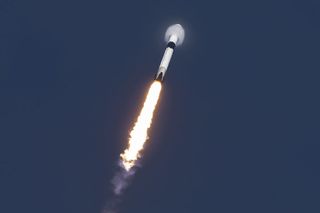Today (Aug. 6) is going to be a big day in space!
After a Cygnus cargo spacecraft departs the International Space Station this afternoon, SpaceX and Arianespace will be launching a total of three new communications satellites into orbit. You can watch all three events live here at Space.com.
First up: Cygnus undocking (12:15 p.m. ET)
First, the Cygnus cargo ship will undock from the space station at 12:15 p.m. EDT (1615 GMT). NASA astronauts Nick Hague and Christina Koch will use the station's Canadarm2 robotic arm to release the vessel into the vacuum of space. NASA TV will provide live coverage of the send-off beginning 15 minutes prior to its departure.
The Cygnus arrived at the space station in April with 7,600 lbs. (3,447 kilograms) of supplies and experiments for the astronauts on board. Instead of heading straight toward Earth to burn up in the atmosphere, as departing cargo ships typically do, this Cygnus will stay in orbit for a few months to test a new cubesat-deploying contraption called "SlingShot."
Above is a video of the last time a Cygnus spacecraft returned to Earth.
Ariane 5 rocket launch (3:30 p.m. ET)
Next, the European launch provider Arianespace will launch two communications satellites on an Ariane 5 rocket. It will lift off from the Guiana Space Center in Kourou, French Guiana at 3:30 p.m. EDT (1930 GMT). This will be the first launch for Arianespace since the company's Vega rocket experienced a launch failure in July.
For this mission, Arianespace is launching the Intelsat 39 telecommunications satellite, which will serve "broadband networking, video and government customers across Africa, Asia, Europe, the Middle East and Indian Ocean region," according to Arianespace's description of the mission.
The second satellite, named EDRS-C, will be the second satellite of the "SpaceDataHighway" — also known as the European Data Relay System — and will provide high-speed laser communications between satellites in low Earth orbit and ground tracking stations down on Earth. It will enable near-real-time processing of images and data from various Earth-observing satellites.
A live webcast of this launch will begin about 15 minutes prior to liftoff. You can watch it here on Space.com, courtesy of Arianespace, or directly via the company's YouTube.
This launch window is open until 5:51 p.m. EDT (2151 GMT). The Intelsat 29 satellite is expected to deploy 29 minutes after liftoff, and EDRS-C will follow just 4 minutes later.
SpaceX Falcon 9 rocket launch (6:52 p.m. ET)

A vapor cloud forms around the nose of the SpaceX Falcon 9 rocket carrying the Es'Hail-2 satellite into space in this dazzling photo of the launch from NASA's Kennedy Space Center in Florida on Nov. 15, 2018.
(Image credit: SpaceX )
Last but not least, SpaceX will launch a Falcon 9 rocket with the Amos-17 satellite. Amos-17 is a communications satellite built by Boeing for Spacecom Ltd. of Israel, and it will provide broadband connectivity over Africa, Europe and the Middle East.
The Falcon 9 rocket will lift off from Space Launch Complex 40 at Florida's Cape Canaveral Air Force Station during a 1-hour, 28-minute launch window that opens at 6:52 p.m. EDT (2252 GMT). The mission was delayed from last week after SpaceX discovered a valve issue with the Falcon 9.
You can watch the live webcast here on Space.com, courtesy of SpaceX, or directly via the company's YouTube.
Email Hanneke Weitering at hweitering@space.com or follow her @hannekescience. Follow us on Twitter @Spacedotcom and on Facebook.
https://www.space.com/2-rocket-launches-and-cygnus-undocking-webcasts.html
Tidak ada komentar:
Posting Komentar